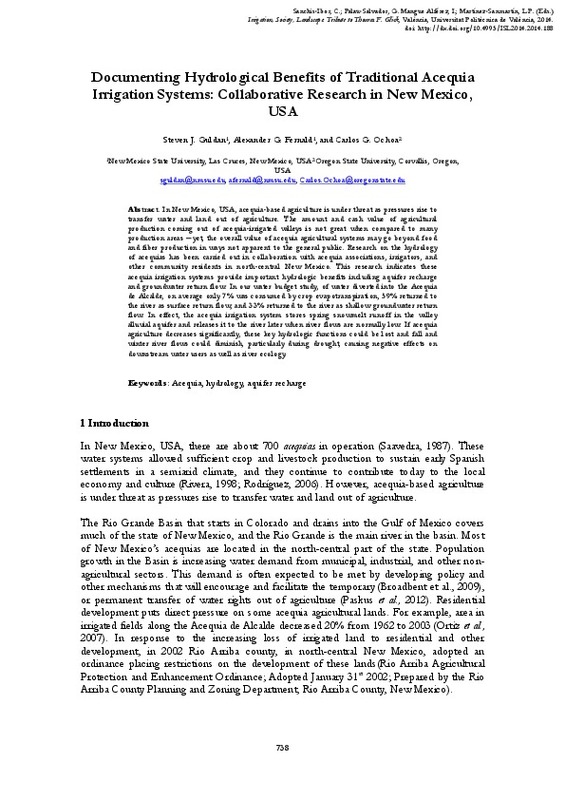JavaScript is disabled for your browser. Some features of this site may not work without it.
Buscar en RiuNet
Listar
Mi cuenta
Estadísticas
Ayuda RiuNet
Admin. UPV
Documenting Hydrological Benefits of Traditional Acequia Irrigation Systems: Collaborative Research in New Mexico, USA
Mostrar el registro sencillo del ítem
Ficheros en el ítem
| dc.contributor.author | Guldan, Steven J.
|
es_ES |
| dc.contributor.author | Fernald, Alexander G.
|
es_ES |
| dc.contributor.author | Ochoa, Carlos G.
|
es_ES |
| dc.date.accessioned | 2017-09-27T07:18:46Z | |
| dc.date.available | 2017-09-27T07:18:46Z | |
| dc.date.issued | 2015-03-03 | |
| dc.identifier.isbn | 9788490482742 | |
| dc.identifier.uri | http://hdl.handle.net/10251/88024 | |
| dc.description.abstract | [EN] In New Mexico, USA, acequia-based agriculture is under threat as pressures rise to transfer water and land out of agriculture. The amount and cash value of agricultural production coming out of acequia-irrigated valleys is not great when compared to many production areas – yet, the overall value of acequia agricultural systems may go beyond food and fiber production in ways not apparent to the general public. Research on the hydrology of acequias has been carried out in collaboration with acequia associations, irrigators, and other community residents in north-central New Mexico. This research indicates these acequia irrigation systems provide important hydrologic benefits including aquifer recharge and groundwater return flow. In our water budget study, of water diverted into the Acequia de Alcalde, on average only 7% was consumed by crop evapotranspiration, 59% returned to the river as surface return flow, and 33% returned to the river as shallow groundwater return flow. In effect, the acequia irrigation system stores spring snowmelt runoff in the valley alluvial aquifer and releases it to the river later when river flows are normally low. If acequia agriculture decreases significantly, these key hydrologic functions could be lost and fall and winter river flows could diminish, particularly during drought, causing negative effects on downstream water users as well as river ecology. | es_ES |
| dc.format.extent | 13 | es_ES |
| dc.language | Inglés | es_ES |
| dc.publisher | Editorial Universitat Politècnica de València | es_ES |
| dc.rights | Reconocimiento - No comercial - Sin obra derivada (by-nc-nd) | es_ES |
| dc.subject | Irrigation | es_ES |
| dc.subject | Society | es_ES |
| dc.subject | Landscape | es_ES |
| dc.subject | Regadío | es_ES |
| dc.subject | Sociedad | es_ES |
| dc.subject | Territorio | es_ES |
| dc.subject | Paisaje | es_ES |
| dc.subject | Patrimonio hidráulico | es_ES |
| dc.subject | Water heritage | es_ES |
| dc.title | Documenting Hydrological Benefits of Traditional Acequia Irrigation Systems: Collaborative Research in New Mexico, USA | es_ES |
| dc.type | Capítulo de libro | es_ES |
| dc.type | Comunicación en congreso | es_ES |
| dc.identifier.doi | 10.4995/ISL2014.2014.188 | |
| dc.rights.accessRights | Abierto | es_ES |
| dc.description.bibliographicCitation | Guldan, SJ.; Fernald, AG.; Ochoa, CG. (2015). Documenting Hydrological Benefits of Traditional Acequia Irrigation Systems: Collaborative Research in New Mexico, USA. Editorial Universitat Politècnica de València. 738-750. https://doi.org/10.4995/ISL2014.2014.188 | es_ES |
| dc.description.accrualMethod | OCS | es_ES |
| dc.relation.conferencename | Irrigation, Society and Landscape. Tribute to Tom F. Glick | es_ES |
| dc.relation.conferencedate | September 25-27,2014 | es_ES |
| dc.relation.conferenceplace | Valencia, Spain | es_ES |
| dc.relation.publisherversion | http://ocs.editorial.upv.es/index.php/ISL/ISL2014/paper/view/188 | es_ES |
| dc.description.upvformatpinicio | 738 | es_ES |
| dc.description.upvformatpfin | 750 | es_ES |
| dc.type.version | info:eu-repo/semantics/publishedVersion | es_ES |
| dc.relation.pasarela | OCS\188 | es_ES |








